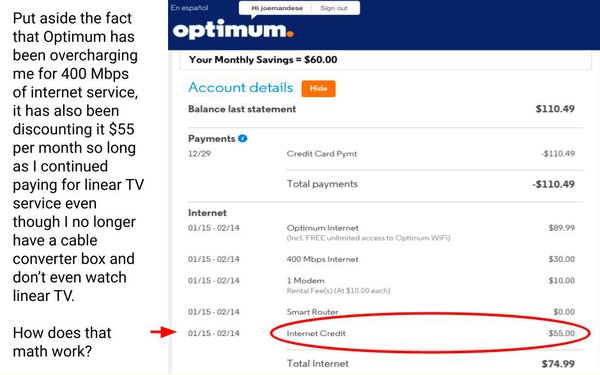
I finally did it. I’ve completely cut
the TV cord. But the truth is, even though I’ve been “connected” to linear TV for the past three years, I never watched it. For some odd reason, my local cable provider –
Altice’s Optimum service – wouldn’t actually let me cut my linear TV service from my package, even though I only wanted, and only use, its broadband connection to access TV via a
vMVPD (YouTube TV).
But instead of letting me cut the linear TV cord completely, it discounted the total cost of my broadband plus TV package so it was significantly cheaper than
paying for broadband alone. The problem was that it required me to call back each year on the anniversary of the deal-- spend hours speaking with a customer rep on the phone -- in order to renew
it.
This went on for three years, and each time I dreaded the friction of the process and scratched my head about why I was doing it, or why Optimum was handling things that way. All
I could figure out was that it was part of their deal with my local public service commission or regional regulators, but none of the reps I spoke to could explain it.
advertisement
advertisement
The bottom
line is that it was just too much friction to be sustainable, and when a competitor finally came into my rural market with a competitive broadband-only package, I signed up for it. Bye-bye
Optimum.
What’s the lesson here?
It’s that the last thing TV operators need to do in an era of ubiquitous choice is to create customer friction. Whether
it is access providers, subscription services, or ad-supported programming channels. There’s just too many options and choices for working around them.
The irony is that up
until now, TV has been the least frictionless video programming option.
I mean, it was intentionally engineered and regulated to have standardized technology that enabled every
American household to simply turn their sets on to receive it. Sure terrestrial TV reception had some signal problems in the days of rabbit-ear or rooftop antennas, but cable TV and digital spectrum
and receivers pretty much resolved that, and with the exception of some MVPD service disruptions, TV just worked.
By comparison, the less standardized over-the-top video marketplace
has gone through fits and starts of technological innovation to get to the point where it’s now pretty much seamless connectivity, as long as you have stable internet access.
And all I can say is I cannot wait until I have a 5G -- or better -- wireless router in my household so I can cut the cord altogether.
The video marketplace should not be
about wires and connectivity -- it should be about programmers and marketers offering the best content and experiences that people are willing to pay for. The rest is just a matter of what products
and business models people are willing to pay for. And keep paying for. Without calling back once a year to renew a deal that creates friction, feels scammy and creates some discomfort for your
customers.
On that last note, I do think the burgeoning subscription-video marketplace still functions a little bit that way -- staggering content to hook, retain, then lose
subscribers until the next batch of compelling content comes along. And for the life of me, I don’t understand why developing a forced-churn marketplace is necessary.
Just be
honest with your customers and tell them up front what your deal is with them. Lay out your programming plans, and provide a subscription package that justifies an ongoing relationship, not one that
creates unsustainable, sporadic consumer relationships.
Those are principles the best marketers of any product premised on customer loyalty understand, and they are probably good
ones for the marketers of programming services in an ultra-competitive marketplace to understand and embrace too.